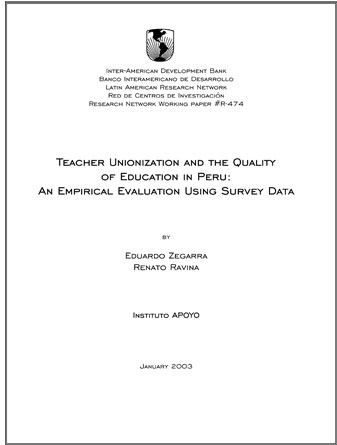Teacher unionization and the quality of education in Peru: an empirical evaluation using survey data
| Año | : | 2002 |
|---|---|---|
| Autor/es | : | Eduardo Zegarra, Renato Ravina |
| Área/s | : | Educación y aprendizajes, Reforma del Estado e instituciones públicas |
[2002] ZEGARRA, Eduardo; RAVINA, Renato. Teacher unionization and the quality of education in Peru: an empirical evaluation using survey data. Washington, D.C.: BID. 35 p. Research network working papers, R-474.
This paper analyzes the evolution and current profile of teacher unionization and estimate the impact of unionization on the quality of public education in Peru.
The research uses data from a 1999 household survey (ENAHO) and from a recent evaluation of a public program oriented to improve the quality of Peruvian public education. Regarding the evolution of unionization, there is evidence compatible with the hypothesis that the rate of teacher unionization has dropped during the last three decades, but especially during the 1990s, due basically to the hiring of temporary teachers. With respect to the profile of unionization, it is found that unionized teachers are older and more experienced, and that males are more common in the union membership.
There is no empirical evidence that unionized teachers enjoy better access to educational infrastructure at the polidocente (larger) schools, but they do have better access at the multigrado (intermediate) schools.
For the impact of unionization on quality, Hoxby’s production function model was adapted to the Peruvian case, in which public education is centralized and in which teachers do not have major influence on the education budget at the school or district levels. The model is estimated to test whether unionization has an impact on teachers’ effort and student achievement, but there is no empirical support for these hypotheses.
The data indicate that unionization does not currently seem to be a major factor affecting the quality of educational services in the Peruvian public education system.






